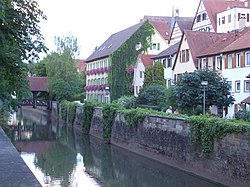Bietigheim-Bissingen
You can help expand this article with text translated from the corresponding article in German. (February 2009) Click [show] for important translation instructions.
|
Bietigheim-Bissingen | |
|---|---|
 Bietigheim Altstadt | |
| Country | Germany |
| State | Baden-Württemberg |
| Admin. region | Stuttgart |
| District | Ludwigsburg |
| Subdivisions | 5 |
| Government | |
| • Mayor | Jürgen Kessing (SPD) |
| Area | |
| • Total | 31.29 km2 (12.08 sq mi) |
| Elevation | 200 m (700 ft) |
| Population (2022-12-31)[1] | |
| • Total | 43,755 |
| • Density | 1,400/km2 (3,600/sq mi) |
| Time zone | UTC+01:00 (CET) |
| • Summer (DST) | UTC+02:00 (CEST) |
| Postal codes | 74301–74321 |
| Dialling codes | 07142 |
| Vehicle registration | LB |
| Website | www.bietigheim-bissingen.de |
Bietigheim-Bissingen is the second-largest town in the district of Ludwigsburg, Baden-Württemberg, Germany with 42,515 inhabitants in 2007. It is situated on the river Enz and the river Metter, close to its confluence with the Neckar, about 19 km north of Stuttgart, and 20 km south of Heilbronn.
History
Towards the end of the 18th century saw Bietigheim during the beginning of the industrialisation an improvement of the living conditions and an increase in population. The 1806 furnished Oberamt Bietigheim was 1810, however, dissolved again: The city and its official municipalities were integrated in the Oberamt Besigheim. After Bietigheim was connected mid-19th century to the railway network and the, the city experienced a real breakthrough and a sustained recovery. At the end of the 19th century there were 3,800 inhabitants. In 1938, Bietigheim came to the new Ludwigsburg (district). A branch of the Nazi Party was in Bietigheim since 1928. Until 1933, this was with 51 members relatively small. After the Nazi seizure of power there were 181 new entrants. By the end of the Nazi regime finally were 939 party members in Bietigheim, representing 10.4 percent of the total population in 1945. [2]
Buildings and sights

- 287 m long Bietigheim Enz Valley Bridge (German: "Bietigheimer Enzviadukt") (built in 1853)
- Old gate (only one still present, built in the 14th century)
- (Protestant) church in Downtown Bietigheim (built in 1401)
- Town hall (built in 1506)
- "Hornmoldhaus" (built in 1536)
- Castle of Bietigheim (built in 1546, renovated between 2000 and 2002), nowadays home to the Bietigheim-Bissingen music school
Infrastructure
Bietigheim-Bissingen station is located on an important railway junction on the Western Railway (connecting Stuttgart with Karlsruhe and Heidelberg) and the Franconia Railway to Heilbronn. Line 5 of the Stuttgart S-Bahn and line 5 of the Stadtbahn Karlsruhe both start here.
Sons and daughters of the town

- Erwin Bälz (1849-1913), personal physician of the Imperial House of Japan and co-founder of modern medicine in Japan
- Elisabeth Goes (1911-2007), pastor's wife and Righteous Among the Nations
- Kurt Hager (1912-1998), member of the Politbüro of the SED in GDR
- Gebhard Fürst (born 1948), bishop of Rottenburg-Stuttgart and a member of the National Ethics Council
- Michael Jacobi (born 1960), member of Parliament from 1988 to 1991
- Heiko Maile, Marcus Meyn and Oliver Kreyssig, members of the German pop group Camouflage
- Matthias Ettrich, (born 1972) founder of KDE
- Roland Bless (born 1961) and Ingo Reidl (born 1961), members of the German pop group Pur
- Namosh, (born 1981) a German musician and singer
- Bernd Leno, (born 1992) a football goalkeeper
People who lived there
- Ottmar Mergenthaler, (1854-1899), inventor of the Linotype typesetting machine, spent four years in Bietigheim during his apprenticeship to a watchmaker
Events
- Bietigheim Horse Market
- Music Exchange with Shawnee Mission South High School symphonic band every 4 years[3]
- Music Exchange with Shawnee Mission South High School string orchestra every 4 years[4]
- Music Exchange with Community High School District 99 Honors Band and Orchestra (Downers Grove, IL) every 2 years.
Business and industry
International relations
Bietigheim-Bissingen is twinned with:
 Kusatsu (Japan) (since 1962)
Kusatsu (Japan) (since 1962) Sucy-en-Brie (France) (since 1967)
Sucy-en-Brie (France) (since 1967) Surrey Heath (United Kingdom) (since 1971)
Surrey Heath (United Kingdom) (since 1971) Szekszárd (Hungary) (since 1989)
Szekszárd (Hungary) (since 1989) Overland Park, USA (since 1999)
Overland Park, USA (since 1999) Saltara, ITA (since 2006)
Saltara, ITA (since 2006)
References
- ^ "Bevölkerung nach Nationalität und Geschlecht am 31. Dezember 2022" [Population by nationality and sex as of December 31, 2022] (CSV) (in German). Statistisches Landesamt Baden-Württemberg. June 2023.
- ^ Michael Schirpf: Strukturbild der NSDAP in Bietigheim. In: Amerikanische Besatzung und Wiederaufbau 1945–1948. Blätter zur Stadtgeschichte, Heft 4, Bietigheim-Bissingen 1985.
- ^ teacherweb.com/KS/ShawneeMissionSouth/MrSteveAdamsBandDirector/h3.stm - 14k -
- ^ http://southorchestras.org/bostonnyc/



